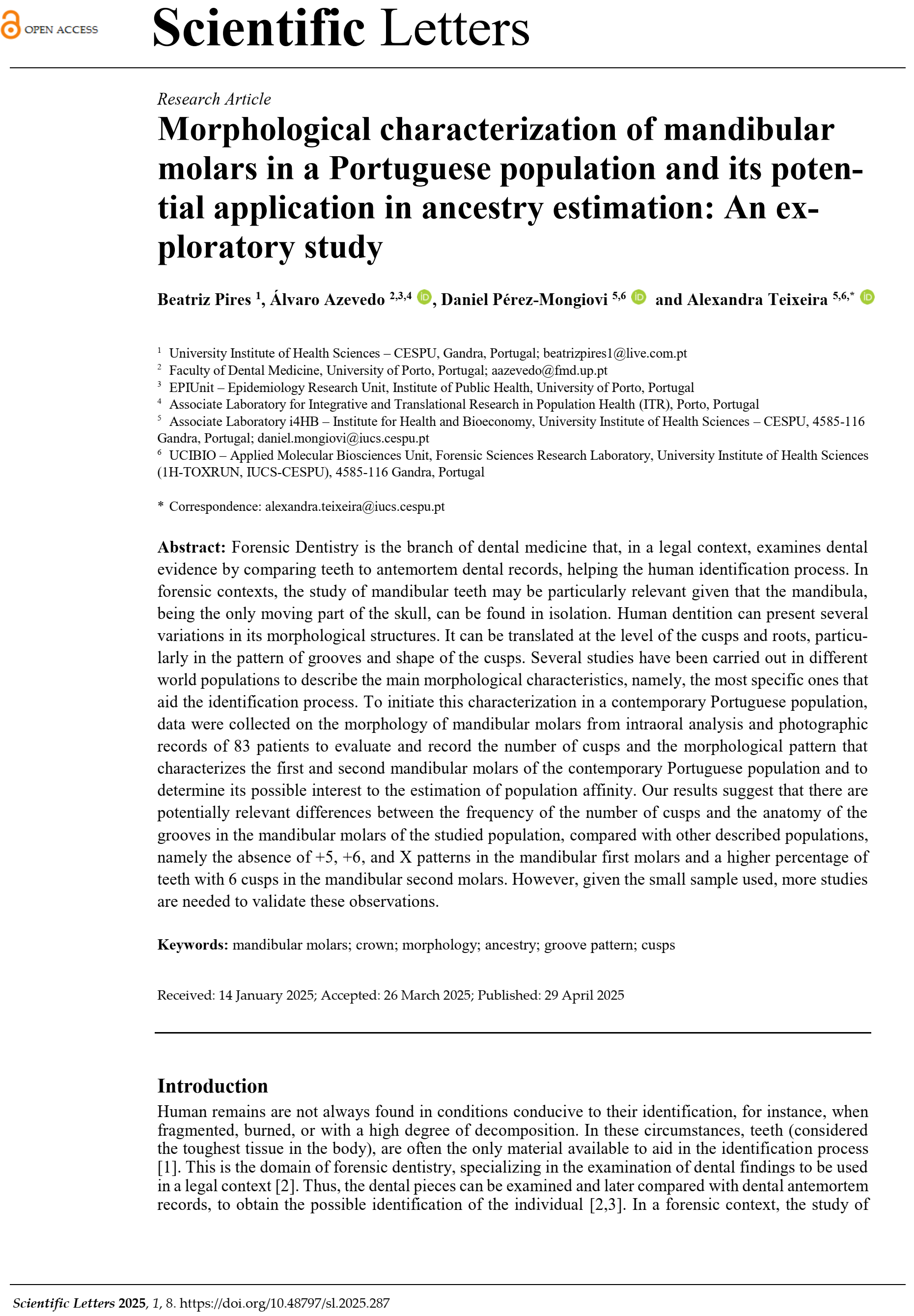Morphological characterization of mandibular molars in a Portuguese population and its potential application in ancestry estimation: An exploratory study
DOI:
https://doi.org/10.48797/sl.2025.287Keywords:
mandibular molars, crown morphology, ancestry, groove pattern, CuspsAbstract
Forensic Dentistry is the branch of dental medicine that, in a legal context, examines dental evidence by comparing teeth to antemortem dental records, helping the human identification process. In forensic contexts, the study of mandibular teeth may be particularly relevant given that the mandibula, being the only moving part of the skull, can be found in isolation. Human dentition can present several variations in its morphological structures. It can be translated at the level of the cusps and roots, particularly in the pattern of grooves and shape of the cusps. Several studies have been carried out in different world populations to describe the main morphological characteristics, namely, the most specific ones that aid the identification process. To initiate this characterization in a contemporary Portuguese population, data were collected on the morphology of mandibular molars from intraoral analysis and photographic records of 83 patients to evaluate and record the number of cusps and the morphological pattern that characterizes the first and second mandibular molars of the contemporary Portuguese population and to determine its possible interest to the estimation of population affinity. Our results suggest that there are potentially relevant differences between the frequency of the number of cusps and the anatomy of the grooves in the mandibular molars of the studied population, compared with other described populations, namely the absence of +5, +6, and X patterns in the mandibular first molars and a higher percentage of teeth with 6 cusps in the mandibular second molars. However, given the small sample used, more studies are needed to validate these observations.
References
Kenyhercz, M.W.; Klales, A.R.; Kenyhercz, W.E. Molar Size and Shape in the Estimation of Biological Ancestry: A Comparison of Relative Cusp Location Using Geometric Morphometrics and Interlandmark Distances. Am J Phys Anthropol 2014, 153, 269–279, doi:10.1002/ajpa.22429.
Nazir, M.A.; Al‐Ansari, A.; Al‐Khalifa, K.; Gaffar, B.O. Determinants of Knowledge and Practice of Forensic Dentistry amongst Dental Practitioners. European Journal of Dental Education 2019, 23, 491–497, doi:10.1111/eje.12457.
Nelson, S.J.; Major M. Ash, Jr. Wheeler’s Dental Anatomy, Physiology, and Occlusion; 9th ed.; Saunders/Elsevier: Missouri, 2010; ISBN 1416062092.
Franco, S.F.; Azevedo, Á.; Matos, V.M.J.; Mongiovi, D.; Teixeira, A. Odontometric Parameters in Human Mandibular Molars for Sex Estimation in a Forensic Context. Dental Anthropology Journal 2021, 34, 36–43, doi:10.26575/DAJ.V34I2.326.
Venkataraghavan, K.; Praveen, P.; Anantharaj, A.; Prathibha Rani, S.; Krishnan, M.B. Bilateral Six Cusped and Three Rooted Man-dibular First Molars. World Journal of Dentistry 2011, 2, 255–258, doi:10.5005/jp-journals-10015-1092.
Edgar, H.J.H. Estimation of Ancestry Using Dental Morphological Characteristics. J Forensic Sci 2013, 58, S3–S8, doi:10.1111/j.1556-4029.2012.02295.x.
Edgar, H.J.H. Testing the Utility of Dental Morphological Traits Commonly Used in the Forensic Identification of Ancestry. Front Oral Biol 2009, 13, 49–54, doi:10.1159/000242390.
Scott, G.R.; Irish, J.D. Human Tooth Crown and Root Morphology: The Arizona State University Dental Anthropology System; Cambridge University Press: Cambridge, 2017; ISBN 9781316156629.
Edgar, H.J.H.; Ousley, S.D. New Approaches to the Use of Dental Morphology in Forensic Contexts. In Anthropological Perspectives on Tooth Morphology: Genetics, Evolution, Variation; Scott, G.R., Irish, J.D., Eds.; Cambridge University Press, 2013; pp. 510–534 ISBN 9781107011458.
Kranioti, E.F.; García-Donas, J.G.; Can, I.O.; Ekizoglu, O. Ancestry Estimation of Three Mediterranean Populations Based on Cranial Metrics. Forensic Sci Int 2018, 286, 265.e1-265.e8, doi:10.1016/J.FORSCIINT.2018.02.014.
Tvedebrink, T. Review of the Forensic Applicability of Biostatistical Methods for Inferring Ancestry from Autosomal Genetic Markers. Genes (Basel) 2022, 13, 141, doi:10.3390/GENES13010141.
Turner, I.. IC.; Nichol, C.; Scott, G. Scoring Procedures for Key Morphological Traits of the Permanent Dentition: The Arizona State University Dental Anthropology System. Advances in Dental Anthropology 1991, 13–31.
Scott, G.R.; Maier, C.; Heim, K. Identifying and Recording Key Morphological (Nonmetric) Crown and Root Traits. In A companion to dental anthropology; Irish, J.D., Scott, G.R., Eds.; Wiley-Blackwell, 2016; pp. 247–264 ISBN 978-1-118-84543-1.
Roy, J.; Rohith, M.M.; Nilendu, D.; Johnson, A. Qualitative Assessment of the Dental Groove Pattern and Its Uniqueness for Forensic Identification. J Forensic Dent Sci 2019, 11, 42, doi:10.4103/JFO.JFDS_73_19.
Hasund, A.; Bang, G. Morphologic Characteristics of the Alaskan Eskimo Dentition: IV. Cusp Number and Groove Patterns of Man-dibular Molars. Am J Phys Anthropol 1985, 67, 65–69, doi:10.1002/AJPA.1330670108.
JØRGENSEN, K.D. The Dryopithecus Pattern in Recent Danes and Dutchmen. J Dent Res 1955, 34, 195–208, doi:10.1177/00220345550340020601.
Mânica, S.; Gorza, L. Forensic Odontology in the 21st Century – Identifying the Opinions of Those behind the Teaching. J Forensic Leg Med 2019, 64, 7–13, doi:10.1016/J.JFLM.2019.03.006.
Gupta, S.K.; Saxena, P. Prevalence of Cusp 7 in Permanent Mandibular First Molars in an Indian Population: A Comparative Study of Variations in Occlusal Morphology. J Investig Clin Dent 2013, 4, 240–246, doi:10.1111/j.2041-1626.2012.00154.x.
Matsuda, T. Studies on the Dryopithecus Pattern of the Japanese Residing in Hokuriku District. Okajimas Folia Anat Jpn 1961, 37, 317–330, doi:10.2535/OFAJ1936.37.4-5_317.
Carneiro, J.L.; Santos, A.; Magalhães, T.; Afonso, A.; Caldas, I.M. Human Identification Using Dental Techniques: A Case Report. Med Sci Law 2015, 55, 78–81, doi:10.1177/0025802414531752.
Marado, L.M.; Silva, A.M. Dental and Oral Nonmetric Traits in a Coimbra Reference Sample: Testing Intrasample Chronological and Spatial Variation. Archaeol Anthropol Sci 2018, 10, 1165–1177, doi:10.1007/s12520-016-0455-4.
Scott, G.; Anta, A.; Schomberg, R.; de la Rúa, C. Basque Dental Morphology and the “Eurodont” Dental Pattern. In Anthropological perspectives tooth morphology genetics evolution variation; Scott, G.R., Irish, J.D., Eds.; Cambridge University Press: Cambridge, 2013; pp. 296–318.
Chagula, W.K. The Cusps on the Mandibular Molars of East Africans. Am J Phys Anthropol 1960, 18, 83–90, doi:10.1002/AJPA.1330180203.
Khrai Sat, A.; Hat, F.A.; Sawai, R.; Shaaweesh, A.I. Entoconulid (Cusp 6), Metaconulid (Cusp 7), Post-Metaconulid and Pre-Entoconulid Expression on Permanent Mandibular First Molar in the Living Jordanian Population and Inter-Trait Interactions. Odontostomatol Trop 2011, 34, 11–19.
Manjunatha, B.; Dholia, B. Occlusal Morphology of Permanent Mandibular First and Second Molars in Gujarati Population. J Forensic Dent Sci 2015, 7, 137, doi:10.4103/0975-1475.146368.
Felemban, N.H.; Manjunatha, B.S. Prevalence of the Number of Cusps and Occlusal Groove Patterns of the Mandibular Molars in a Saudi Arabian Population. J Forensic Leg Med 2017, 49, 54–58, doi:10.1016/J.JFLM.2017.05.013.
Shetty, U.; Shetty, P.; D’Cruz, A. Determination of Cusp Number and Occlusal Groove Pattern in Mandibular Molars: A Preliminary Epidemiological Study in an Indian Population. Journal of Forensic Science and Medicine 2016, 2, 98–101, doi:10.4103/2349-5014.179323.
Loh, H.S. Mongoloid Features of the Permanent Mandibular Second Molar in Singaporean Chinese. Aust Dent J 1991, 36, 442–444, doi:10.1111/J.1834-7819.1991.TB04723.X.
Mosharraf, R.; Ebadian, B.; Ali, Z.; Najme, A.; Niloofar, S.; Leila, K. Occlusal Morphology of Mandibular Second Molars in Iranian Adolescents. Indian J Dent Res 2010, 21, 16–19, doi:10.4103/0970-9290.62802.
Scott, G.R.; Irish, J.D. Anthropological Perspectives on Tooth Morphology: Genetics, Evolution, Variation; Cambridge University Press: Cambridge, 2013; ISBN 9780511984464.
Tantbirojn, D.; Versluis, A.; Pintado, M.R.; DeLong, R.; Douglas, W.H. Tooth Deformation Patterns in Molars after Composite Res-toration. Dental Materials 2004, 20, 535–542, doi:10.1016/J.DENTAL.2003.05.008.

Downloads
Published
How to Cite
Issue
Section
License
Copyright (c) 2025 Beatriz Pires, Álvaro Azevedo, Daniel Pérez-Mongiovi, Alexandra Teixeira

This work is licensed under a Creative Commons Attribution 4.0 International License.
In Scientific Letters, articles are published under a CC-BY license (Creative Commons Attribution 4.0 International License), the most open license available. The users can share (copy and redistribute the material in any medium or format) and adapt (remix, transform, and build upon the material for any purpose, even commercially), as long as they give appropriate credit, provide a link to the license, and indicate if changes were made (read the full text of the license terms and conditions of use).
The author is the owner of the copyright.








